Xiaosaurus, is a genus of small herbivorous dinosaur from the middle Jurassic, approximately 169 to 163.5 mya. Xiaosaurus lived in what is now the Sichuan Basin of China.
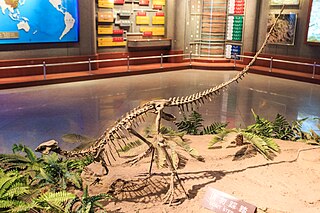
Agilisaurus is a genus of ornithischian dinosaur from the Middle Jurassic Period of what is now eastern Asia. It was about 3.5–4 ft long, 2 ft in height and 40 kg in weight.
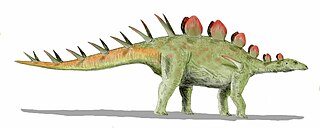
Chialingosaurus is a genus of herbivorous stegosaurian dinosaur similar to Kentrosaurus from the Upper Shaximiao Formation, Late Jurassic beds in Sichuan Province in China. Its age makes it one of the oldest species of stegosaurs, living about 160 million years ago. Since it was an herbivore, scientists think that Chialingosaurus probably ate ferns and cycads, which were plentiful during the period when Chialingosaurus was alive.
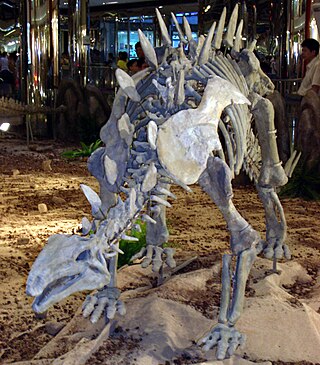
Huayangosaurus is a genus of stegosaurian dinosaur from the Middle Jurassic of China. The name derives from "Huayang" (華陽), an alternate name for Sichuan, and "saurus", meaning "lizard". It lived during the Bathonian to Callovian stages, around 165 million years ago, some 20 million years before its famous relative, Stegosaurus appeared in North America. At only approximately 4 metres (13 ft) long, it was also much smaller than its famous cousin. Found in the Lower Shaximiao Formation, Huayangosaurus shared the local Middle Jurassic landscape with the sauropods Shunosaurus, Datousaurus, Omeisaurus and Protognathosaurus, the ornithopod Xiaosaurus and the carnivorous Gasosaurus.

Tuojiangosaurus is a genus of herbivorous stegosaurian dinosaur from the Late Jurassic Period, recovered from the Upper Shaximiao Formation of what is now Sichuan Province in China.
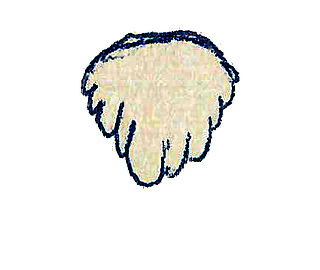
Alocodon is a genus of ornithischian dinosaur known from multiple teeth from the Middle or Late Jurassic Cabaços Formation of Portugal, and also the Forest Marble and Chipping Norton Formations of England. A single species is known, A. kuehnei.
Zigongosaurus is a genus of sauropod dinosaur from the Middle Jurassic-Late Jurassic-age Shaximiao Formation of Zigong, Sichuan, China. Because of incomplete knowledge of Jurassic Chinese sauropods, it has been hard to interpret, with some sources assigning it to Omeisaurus, some to Mamenchisaurus, and some to its own genus.
Trimucrodon is a genus of ornithischian dinosaur from the Late Jurassic Lourinhã Formation of Portugal. The type, and currently only, species is T. cuneatus.

Szechuanosaurus is an extinct genus of carnivorous theropod dinosaur from the Late Jurassic. Fossils referred to the genus have been found in China, Asia in the Oxfordian-?Tithonian. Its type species is based on several undiagnostic teeth from the Kuangyuan Series. Additional possible specimens of Szechuanosaurus were also reported from the Kalaza Formation, also located in China.
Taveirosaurus is a genus of ornithischian dinosaur from the Late Cretaceous Argilas de Aveiro Formation of Portugal, and also Laño, Spain. The genus is based solely on teeth, and the type species is T. costai.
Monkonosaurus is a dubious genus of herbivorous stegosaurian dinosaur from the Late Jurassic/Early Cretaceous-aged Loe-ein Formation of Tibet. Some sources place it as alive during the Oxfordian - Albian stages, around 163 - 100 million years ago, although Monkonosaurus was probably only alive during the Late Jurassic, making it among the earliest known stegosaurs along with Chungkingosaurus and Bashanosaurus.

Laosaurus is a genus of neornithischian dinosaur. The type species, Laosaurus celer, was first described by O.C. Marsh in 1878 from remains from the Oxfordian-Tithonian-age Upper Jurassic Morrison Formation of Wyoming. The validity of this genus is doubtful because it is based on fragmentary fossils. A second species from the Morrison Formation, L. gracilis, and a species from the late Cretaceous Allison Formation of Alberta, Canada, Laosaurus minimus, are also considered dubious.

Nanosaurus is the name given to a genus of neornithischian dinosaur that lived about 155 to 148 million years ago, during the Late Jurassic-age. Its fossils are known from the Morrison Formation of the south-western United States. The type and only species, Nanosaurus agilis, was described and named by Othniel Charles Marsh in 1877. The taxon has a complicated taxonomic history, largely the work of Marsh and Peter M. Galton, involving the genera Laosaurus, Hallopus, Drinker, Othnielia, and Othnielosaurus, the latter three now being considered to be synonyms of Nanosaurus. It had historically been classified as a hypsilophodont or fabrosaur, types of generalized small bipedal herbivore, but more recent research has abandoned these groupings as paraphyletic and Nanosaurus is today considered a basal member of Neornithischia.
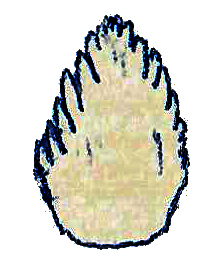
Phyllodon was a genus of small ornithischian dinosaur from the Kimmeridgian-aged Upper Jurassic Camadas de Guimarota Formation of Leiria, Portugal and possibly also the Bathonian-aged Chipping Norton Limestone of England. It may have been closely related to contemporaneous dinosaurs in North America.
Siluosaurus is a genus of ornithopod dinosaur from the Barremian-Albian-age Lower Cretaceous Xinminbao Group of Gansu, China. It is based on the specimen IVPP V.11117 (1-2), which consists of two teeth. It is an obscure genus, with no papers doing more than mentioning it since it was described in 1997. The type species is S. zhanggiani.

Heterodontosauridae is a family of ornithischian dinosaurs that were likely among the most basal (primitive) members of the group. Their phylogenetic placement is uncertain but they are most commonly found to be primitive, outside of the group Genasauria. Although their fossils are relatively rare and their group small in numbers, they have been found on all continents except Australia and Antarctica, with a range spanning the Early Jurassic to the Early Cretaceous.

Dryosauridae was a family of primitive iguanodonts, first proposed by Milner & Norman in 1984. They are known from Middle Jurassic to Early Cretaceous rocks of Africa, Europe, and North America.

The palpebral bone is a small dermal bone found in the region of the eye socket in a variety of animals, including crocodilians and ornithischian dinosaurs. It is also known as the adlacrimal or supraorbital, although the latter term may not be confused with the supraorbital in osteichthyan fishes. In ornithischians, the palpebral can form a prong that projects from the front upper corner of the orbit. It is large in heterodontosaurids, basal ornithopods such as Thescelosaurus and Dryosaurus, and basal ceratopsians such as Archaeoceratops; in these animals, the prong is elongate and would have stuck out and over the eye like a bony eyebrow. As paleoartist Gregory S. Paul has noted, elongate palpebrals would have given their owners fierce-looking "eagle eyes". In such cases, the expanded palpebral may have functioned to shade the eye.
The Kiyosu-e Formation is a Middle Jurassic (Callovian) to Early Cretaceous (Berriasian) geologic formation of the Toyonishi Group in Yamaguchi Prefecture, Japan. Fossil ornithopod tracks have been reported from the formation.
The Razorback Beds is an Early Jurassic geologic formation in Queensland, Australia. Fossil ornithopod tracks have been reported from the formation.














